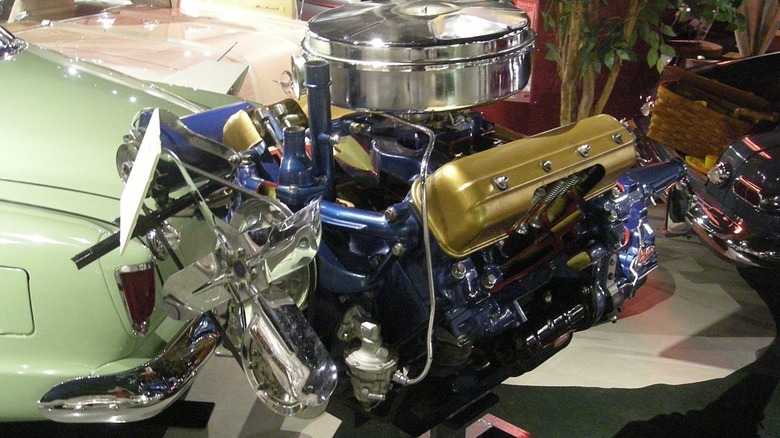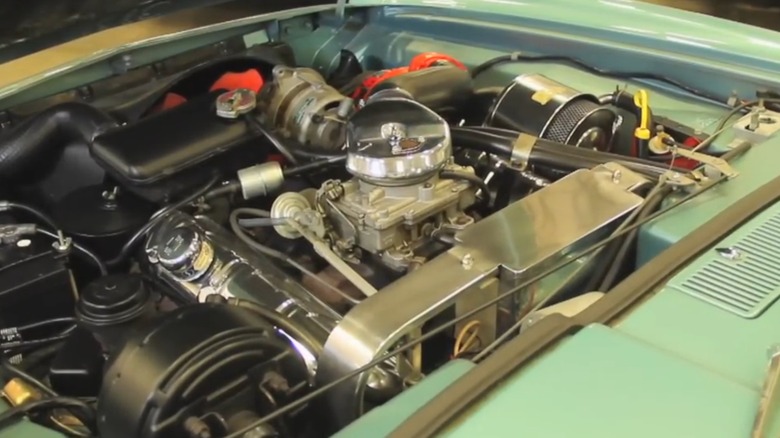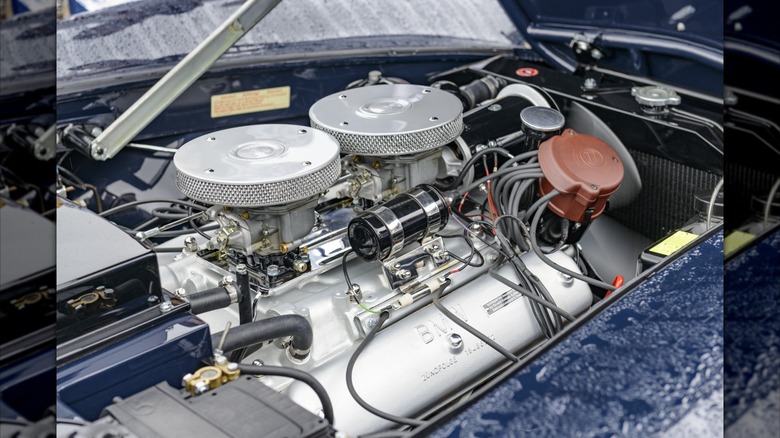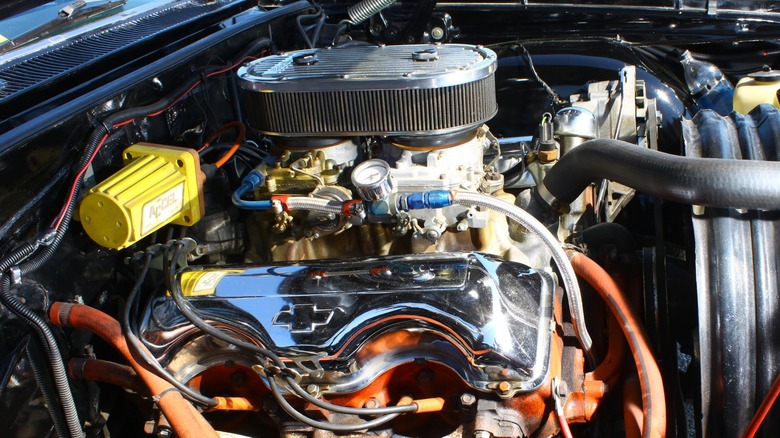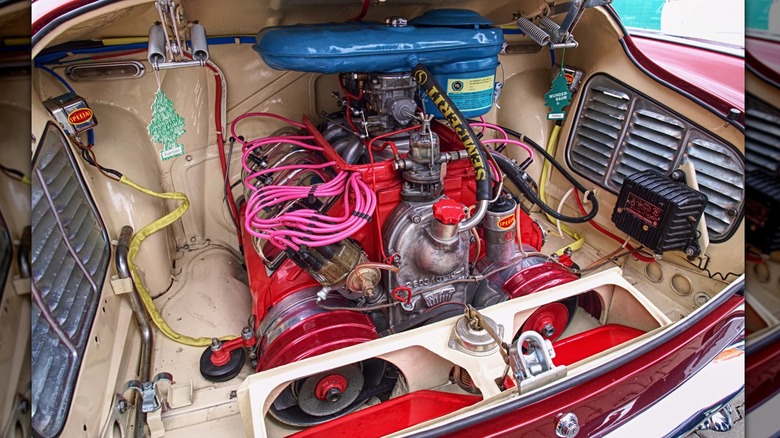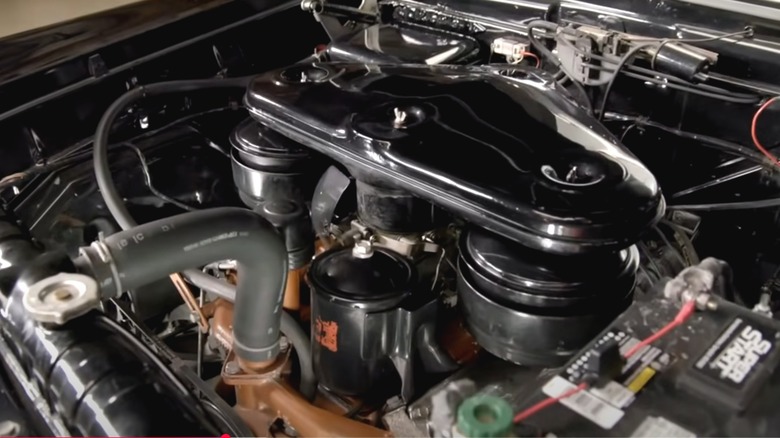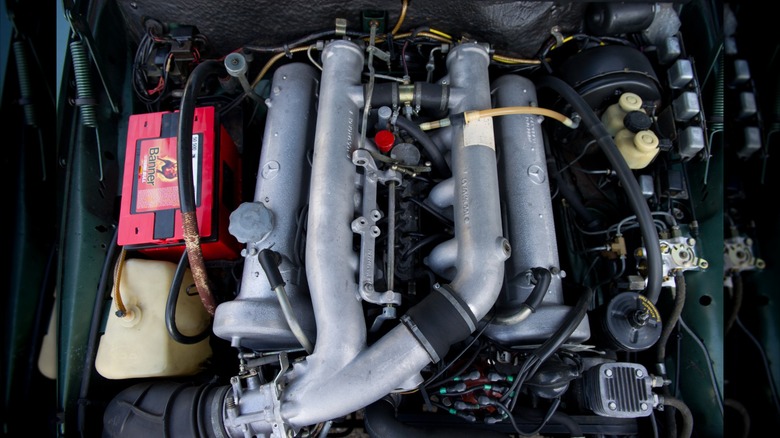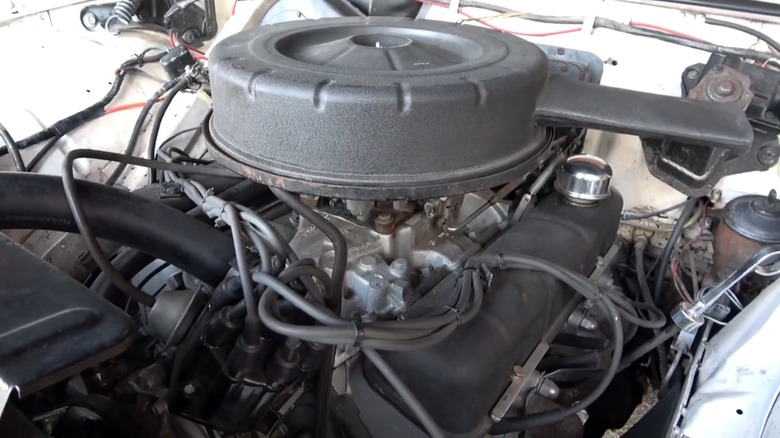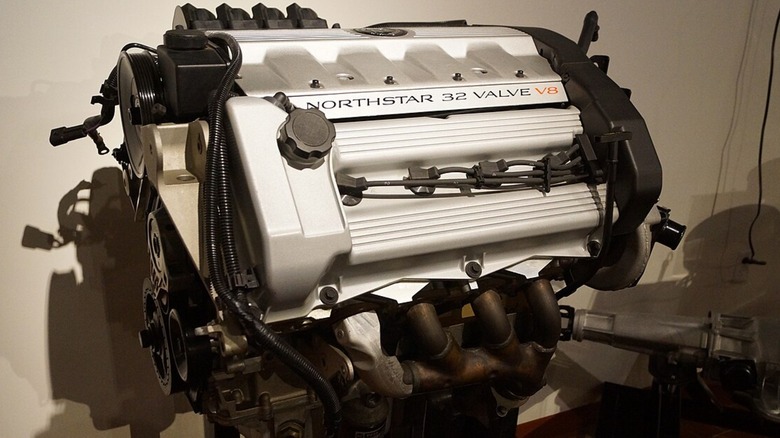8 Classic V8 Engines That Didn't Deserve To Be Forgotten
If you have gone car shopping lately, chances are that most of the cars offered to you are powered by turbocharged four-cylinder engines. This is the trend these days, but at one time, dealer lots were dominated by V8-powered models. In a time when imports had yet to take hold, domestic manufacturers stuck them into everything from compacts to luxury barges. This practice peaked in the '70s as foreign competition moved in with smaller and more efficient cars and high fuel prices pushed Americans into prioritizing efficiency when car shopping.
Despite this shift toward turbocharged efficiency, the V8 is not yet dead, but let's a moment to celebrate the industry juggernauts of yesterday. The Ford Flathead, Chevrolet small-block, Chrysler 426 Hemi, and even the Pontiac 455 were all some of the greatest American V8s ever made, but scores of other options from manufacturers at home and abroad have contributed to the rich mechanical history cherished by so many of us. Of course, some oddball designs that failed to live up to their makers' promises might best be left in the past, but a few choice gems remain under-appreciated and overlooked. Here are eight models deserving of our continued attention.
Studebaker V8
Ford, Chrysler, and Chevrolet all have histories dating back to the early part of the 20th century, but one of their old competitors had roots decades before any of them. With a history of building stagecoaches dating back to the 1850s, automaker Studebaker stood its ground for decades against the big automotive conglomerates, but the 1950s saw it hurtling toward bankruptcy. However, before its demise finally came, Studebaker managed to create what might be among the best V8 engines of the era.
Getting out ahead of the competition, Studebaker released its new overhead-valve V8 in 1951, before both Ford and Chevrolet. The new engine featured relatively small valves and used gears for the camshaft instead of a chain. These decisions and others resulted in the Studebaker V8 being incredibly reliable, while providing excellent power for its size – only the then-new Chrysler Hemi outclassed it, initially. Later, to overcome breathing issues from the smaller valves, Studebaker pioneered using superchargers for high-performance applications and even acquired Paxton Products, gaining its own supercharger supplier and later developing the 289-hp R2 V8.
If it had been able to continue into the muscle car era, the Studebaker V8 had the potential to be one of the great American V8s. However, a factory race-ready 1963 Avanti Due Cento with dual superchargers and Bendix fuel injection making 638 hp suggests it already was.
BMW OHV V8
Although BMW had to work to get itself together to build cars for the public in the post-war period, the company had been building them for decades at that point. Historically, all of its engines had been built with an inline configuration only, making its new OHV V8, introduced in 1954, unique and novel.
Available first as a 2.6-liter version and later joined by a 3.2-liter variant, the new V8, simply known as the BMW OHV V8, became the first all-aluminum V8 produced in Germany. The final engine design shared many of its properties with the recently released Oldsmobile 303 Rocket V8. However, unlike the American unit, the BMW came in at about half the size and featured both heads and block made of alloys, making it both compact and lightweight. And with output of 100 horsepower, it provided generous power for the era, especially given its size.
Initially, the OHV V8 was created to power BMW luxury cars built in small numbers for affluent buyers. But in 1956, the company released the elegant 507 roadster, powered by the 3.2-liter OHV V8, but with dual carburetors boosting output up 150 hp. When production ended in 1964, another BMW V8 would not come until 1990. With low production numbers, anyone who gets to experience this early BMW V8 shall cherish it.
Chevrolet Turbo-Thrust 409
Cars often become the subject of popular songs that permeate our collective psyche, but an engine is rarely made the focus. Nonetheless, the Beach Boys chose to hone in on the big-block Chevrolet 409 for the B-side to their hit song "Surfin' Safari." The inspiration for "409" came from songwriter Brian Usher's love of cars, with the Chevrolet 409 engine being a favorite, though the engine sounds in the song actually come from a 326.
Aside from 1960s pop music, the 409 is known for being an early powerhouse of the era. Its design is unique, featuring heads with a completely flat deck and a combustion chamber formed by a slanted piston, which forms a wedge-shaped chamber at TDC. Another unique trait is a staggered valve arrangement, allowing for much larger diameter valves installed. Otherwise, it was mostly standard GM engine architecture, but its power delivery was well above board.
Initially, the new Turbo-Thrust V8 was rated from the factory at 360 hp, which was quite respectable in 1961. This first version came with a single Carter AFB 4-barrel carburetor, but options for dual Carters or triple 2-barrels soon followed. And while a hit song helped boost its popularity, 409-powered cars winning on the drag strip on Saturdays proved its mettle, sending performance buyers into the showroom on Monday mornings. Chevrolet's production 409 was an early salvo in the horsepower war to come over the decade.
Tatra V8
Most American readers likely know little about the automotive history of Czechia. This is understandable since much of it happened behind the Iron Curtain. However, one engine that predated the Berlin Wall and even WWII survived the communist era, and it is fascinating.
Developed in 1934 by Czech automaker Tatra, the 77a received aerodynamic styling by Hans Ledwinka and came with an air-cooled engine in the back, similar to the VW Type 1. Unlike the VW, the Tatra engine had eight cylinders with a 2.9-liter displacement. Good for a top speed of 90 mph — extremely fast for cars in the '30s — the real claim to fame of the 77a and its successors is the tendency to kill high-ranking Nazi officers who, unfamiliar with their handling, found themselves careening out of control. This was certainly the car's best ability.
Tatra also made a magnesium block V8 with overhead cams for its T87 from 1936 to 1950. After a six-year hiatus, production restarted on the Tatra 603, another executive car driven primarily by Soviet party leaders and remained in production until 1975. Through all of this production, the Tatra V8 remained hanging out the back with fans for cooling. By the time communism fell, the Tatra V8 had grown to 3.5 liters with quad cams and even received fuel injection. Quirky and anachronistic, a Tatra V8 may not be the best V8 engine ever made, but it is definitely the most interesting.
Packard V8
At one time, the Packard name represented some of the most opulent automobiles one could buy. But after the war, the company failed to get its footing, eventually merging with Studebaker as it continued to lose market share. Packard was late getting a V8 into production, but even before the 1954 merger, development was already underway, and that new Packard V8 would be released in 1955.
Packard finally retired its venerable flathead straight-eight engine in 1955 in favor of the new OHV V8. Available in sizes of 320, 352, and 374, it offered competitive output up to 310 hp on the largest model, equipped with dual four-barrel Rochester carburetors. While most of the design remained relatively conventional, Packard engineers had put thought into its design and included a robust crankshaft with forged rods and fully machined combustion chambers. All the ingredients for a good and reliable engine made it to production, though there were one or two complaints about the transmission. Unfortunately, Packard's automatic couldn't handle the torque and limited the engine's potential.
Hot rodders of the day saw potential and began modifying them for use on the track. However, the Packard V8 only lasted two years, drying up any potential for further use in any application, much less racing. Packard itself only lasted a couple more years rebadging Studebaker models before it was phased out for good.
Mercedes-Benz M100
Today, Mercedes-Benz V8 engines are well known for their ability to create incredible amounts of power thanks to high-tech sophistication and precision engineering. This, however, was not always the case, as Mercedes vehicles were known to be luxurious but not necessarily quick. Nonetheless, even in an era in which their cars came with four-cylinder and six-cylinder inline engines of modest power, one emerged with an extra helping of grunt.
Mercedes built a new model for its most wealthy clientele in 1965. The Mercedes-Benz 600 featured the most opulent interiors with luxury accessories, even offering a limousine version called the Pullman. Bankers, movie stars, and various dictators all loved the Pullman, at least partially for the generous power supplied by its fuel-injected 6.3-liter overhead-cam V8 engine. A very heavy automobile, it required substantial power to keep it moving, and the M100 V8 supplied 250 hp with 369 lb-ft of torque.
A sort of off-books experiment by a Mercedes engineer also led to the introduction of the 300 SEL 6.3. This stuffed the big V8 into a top-line passenger sedan, creating what might be considered Germany's first muscle car. With a big V8 in an unassuming family sedan, drivers at the time could cause panic to Porsche 911 drivers watching the big Benz pass them on the autobahn. You will find few of these modified into performance machines, but the M100 still laid the foundation for today's AMG performance machines.
Buick 215
Buick moved its Special onto the new Senior Compact platform for the 1961 model year. With it came a compact and lightweight V8 perfect for downsize models. To keep from weighing down the smaller cars, Buick engineers chose an all-aluminum engine design, making it the first large-scale production engine to do so – the aluminum BMW OHV V8 preceding it was built in limited numbers only.
Aside from the alloy construction material, the new 215 V8 remained typical of GM engines of the day and came with overhead valves driven by a central cam and pushrods. With a four-barrel carburetor, the 215 was capable of producing a respectable 185 hp while its scant 324 pounds of weight helped the car make every bit of its power. While it proved to be a decent enough engine option, Buick only used it for a couple of years before sending it out to pasture. But what happened after that is what makes the Buick 215 worth remembering.
Buick originally shared the 215 with Pontiac and Oldsmobile. Olds used its version on the first turbocharged production car ever made, a feat unto itself. But more importantly, when GM no longer wanted it, Rover came over from the U.K. and bought the tooling and rights to the design. It then became the Rover 3.5 V8 and stuck around for nearly another 40 years, powering Land Rovers as well as British classics like MGs, Triumphs, TVRs, and Morgans.
Cadillac Northstar
Despite once building some of the finest cars in the world, by the 1980s Cadillac's luster had faded. The brand had developed a reputation for building uninspired cars driven by retired accountants. However, as a new decade dawned, Cadillac wised up and gave us a remarkable engine representing a significant breakthrough for the brand, the Northstar.
The development of Cadillac's new engine demonstrated several firsts for GM, and it showed that Cadillac engineering, with some he had not become completely moribund. Introduced as standard in the 1993 Allante roadster, Seville sedan, and Eldorado coupe, the 4.6-liter V8 featured twin overhead camshafts, four valves per cylinder, multi-port fuel injection, and distributor-less ignition. Its electronics were highly advanced thanks to a new high-power PCM, and upon its introduction, it delivered 295 hp. When the Seville upgraded from its old engine, horsepower increased from 200 to 295, a massive increase coupled with significant weight reduction — the Northstar only weighed about 400 pounds.
While it represented a significant evolutionary step for Cadillac engine development, the Northstar was very flawed. Among other things, the engine had significant problems with stretched head bolts, causing numerous head gasket and overheating problems for owners. Despite these issues, Northstars can be made into good performers with upgraded head bolts and a couple of camshafts. If you want power that is both affordable and sophisticated, a Cadillac may be the right choice.
